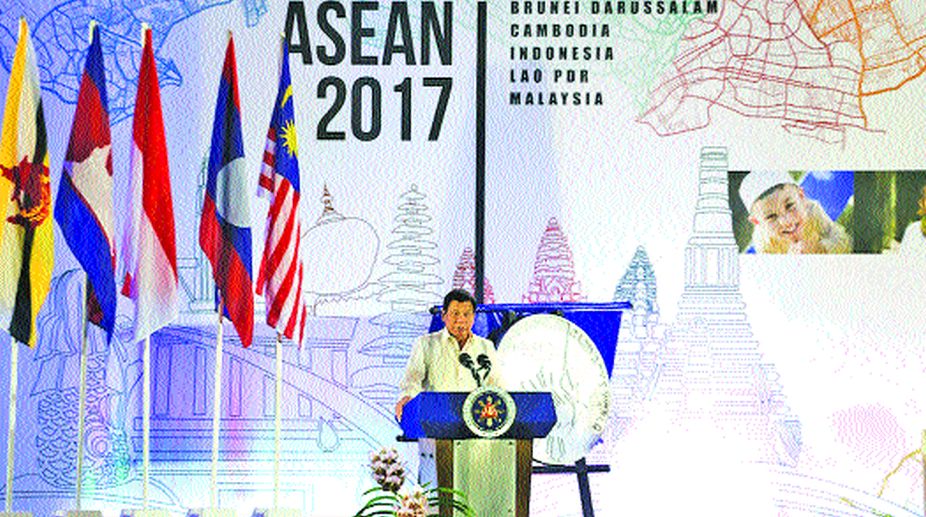PM Modi on 3-day visit to 3 states–MP, Bihar, Assam–from Sunday
According to the Prime Minister’s Office (PMO), the Prime Minister will visit Madhya Pradesh, Bihar and Assam from February 23-25.

Photo: Facebook
This year marks the 25th anniversary of the India-ASEAN Dialogue partnership. In a thoughtful manner Prime Minister Narendra Modi earlier last month reached out to the President of Philippines Rodrigo R. Duterte through a message iterating India’s steadfast support and commitment to the regional architecture. True, the message is occasion-specific. But more than what meets the eye at least two major reasons can be attributed to the Prime Minister’s message to President Duterte.
First, Duterte did an absolute turn around, when he reached out to China disowning the traditional strategic and security alliance with the USA. Not long ago Philippines itself had moved the International Court of Arbitration challenging Chinese claims on the South China Sea. Later the Hague-based international court gave its verdict in favour of Philippines, which was disregarded by Beijing.
Advertisement
India has supported the principle of freedom of navigation and had also welcomed the Hague ruling much to the chagrin of China. Thus the decision to reach out to President Duterte suggests a partial course correction limited to bilateral relations with Philippines under the new regime, although it does not suggest any fundamental dilution of India’s stance on South China Sea.
Advertisement
Second, Philippines will be chairing the ASEAN summit sometime later this year. The 10-member grouping is primarily an economic entity. In recent years it has been playing a very significant role in regional geopolitics. Although USA continues to be the reigning power in the region, there are signs of its slow withdrawal under President Trump, whose major foreign policy action was the decision to withdraw from the Trans-Pacific Partnership (TPP), the economic outfit of the political architecture of ASEAN.
Philippines, the main anchor of the security architecture of USA in the Asia-Pacific, has also distanced itself from Washington under Duterte. Thus, there are question marks over the ‘Pivot to Asia’ policy articulated and pursued by USA under President Obama, although President Trump has made no secret of his stance on South China Sea. Mr. Obama had tried to co-opt India in the ‘Pivot to Asia’ policy.
As of now there is no indication, unlike on the issue of fighting terrorism, as to the extent to which the US would like to engage India in its Asia-Pacific strategy. It is highly unlikely that the South China Sea dispute issue would be raised at the ASEAN summit meeting given the emerging bonhomie between President Duterte and China.
It is pertinent to mention in this context that Vietnam, the major party to the South China Sea issue has reached out to China to manage maritime differences. Only last month the General Secretary of the Communist Party of Vietnam, Nguyen Phu Trong visited China and had a ‘candid exchange of views’ on maritime issues. The two sides pledged to basic and long term solutions to the dispute.
China, a rising power and the second largest world economy, poised to replace USA in a few years, has challenged American supremacy in the region. In fact the spat over the South China Sea is in a way a jockeying for power in the region. While China has the economic clout to oblige member countries, they are wary of its strategic intent. A number of countries in the region have maritime disputes with China.
The US with its nuclear-equipped armada is the net security provider in the region. It is in this backdrop that the countries of ASEAN look forward to India for its benign role for peace and stability in the region. Often strategic analysts, particularly those belonging to the West have painted the construct of a zero-sum game between the two Asian giants in the region. Historical baggage of the cold war, China’s past strategic behavior, its military might and the nature of its political regime have coloured this kind of a binary approach.
It is worth introspecting whether it is desirable for India to acquiesce in the US ‘Pivot to Asia’ policy. India can as well meaningfully engage with ASEAN countries economically, politically and culturally. There is, however, some perception in strategic circles that India’s foray into the South China Sea is a counter to China’s footprints in Pakistan Occupied Kashmir (PoK), besides its desire to explore hydrocarbons in the South China Sea, and advocating freedom of navigation and sea lanes of communication. Since India has iterated these positions time and again, it makes little sense to harp on these issues without any provocation. These gestures should send a positive signal to China.
Strategic partnership with the countries of the region, however, should be made more robust including defence and security relations. India should, however, avoid acquiescing in the US policy of balancing China.
The nature and structure of geo-politics have changed in recent years following the end of the cold war. Not only has there been a paradigm shift from the Atlantic to Asia-Pacific, but the grammar of geopolitics has changed. In these times of uncertainty and unpredictability, India’s strategy in the Asia-Pacific should remain sacrosanct, but its tactics can be tweaked taking into account the unpredictability of US policy towards Asia-Pacific and the churning taking place in the region, particularly after the leadership transition in Philippines.
India should add more economic content to the comprehensive strategic partnership with the countries of the region, particularly in IT and the IT-enabled services sector. Defence and security cooperation should also continue, but it should not give the impression that India is teaming up with USA to contain China. China is India’s neighbour. Engagement with China is not an option, but a strategic necessity.
The writer is a former senior fellow with Institute for Defence Studies and Analyses. The views expressed are personal.
Advertisement